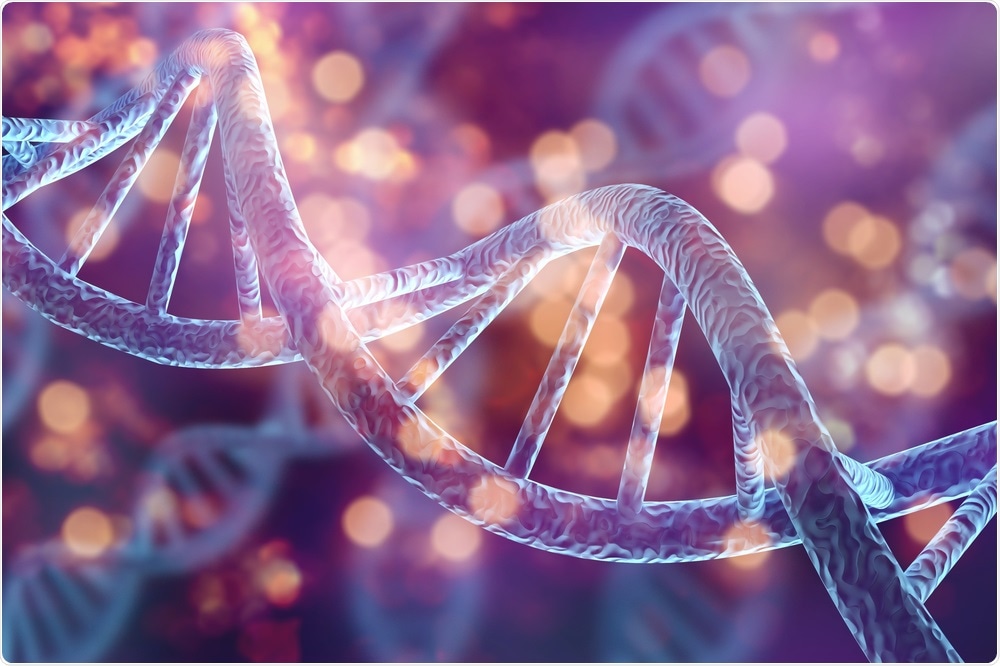Cells include machinery that replicates DNA into a new set, and this, in turn, develops into a newly formed cell.

DNA. Image Credit: Billion Photos/Shutterstock.com
The same group of machines, known as polymerases, also construct RNA messages, which are similar to notes copied from the central DNA repository of instructions, and can be read more efficiently into proteins. Polymerases, on the other hand, were assumed to act only in one direction, that is, from DNA to DNA or RNA.
This inhibits RNA messages from being rewritten into the genomic DNA’s master recipe book. Now, researchers from Thomas Jefferson University have provided the first proof that RNA segments can be transcribed back into DNA, possibly challenging a key assumption in biology that could have far-reaching implications in many domains of biology.
This work opens the door to many other studies that will help us understand the significance of having a mechanism for converting RNA messages into DNA in our own cells. The reality that a human polymerase can do this with high efficiency, raises many questions.”
Richard Pomerantz, PhD, Associate Professor, Biochemistry and Molecular Biology, Thomas Jefferson University
This discovery, for instance, implies that RNA signals can be employed as templates for rewriting or repairing genomic DNA. The results were published in the Science Advances journal.
Dr. Pomerantz’s team began by exploring polymerase theta, a highly rare polymerase, with first author Gurushankar Chandramouly and other colleagues. It was observed that only three of the 14 DNA polymerases in mammalian cells do most of the work of replicating the whole genome to prepare for cell division.
The remaining 11 DNA polymerases are largely involved in identifying and repairing errors or breaks in the DNA strands. Polymerase theta repairs DNA, although it is highly prone to errors and causes many mutations or errors.
As a result, the researchers observed that some of the “bad” qualities of polymerase theta were shared with another cellular mechanism, albeit one more common quality in viruses—the reverse transcriptase. HIV reverse transcriptase, similar to Pol theta, serves as a DNA polymerase that can also bind RNA and read it back into a DNA strand.
In a range of unique experiments, the researchers tested polymerase theta against the reverse transcriptase from HIV, which is one of the most researched of its kind. They demonstrated that polymerase theta could translate RNA signals into DNA, as well as HIV reverse transcriptase, and that it performed better than copying DNA to DNA.
When utilizing an RNA template to create new DNA messages, polymerase theta was more efficient and generated fewer errors, than when replicating DNA into DNA. This indicates that this function may be its principal purpose in the cell.
The researchers worked with Dr. Xiaojiang S. Chen’s team from USC to describe the structure and discovered that this molecule can shift form to fit the bulkier RNA molecule—a breakthrough that is unique among polymerases.
Our research suggests that polymerase theta's main function is to act as a reverse transcriptase. In healthy cells, the purpose of this molecule may be toward RNA-mediated DNA repair. In unhealthy cells, such as cancer cells, polymerase theta is highly expressed and promotes cancer cell growth and drug resistance. It will be exciting to further understand how polymerase theta's activity on RNA contributes to DNA repair and cancer-cell proliferation.”
Richard Pomerantz, PhD, Associate Professor, Biochemistry and Molecular Biology, Thomas Jefferson University
Source:
Journal reference:
Chandramouly, G., et al. (2021) Polθ reverse transcribes RNA and promotes RNA-templated DNA repair. Science Advances. doi.org/10.1126/sciadv.abf1771.